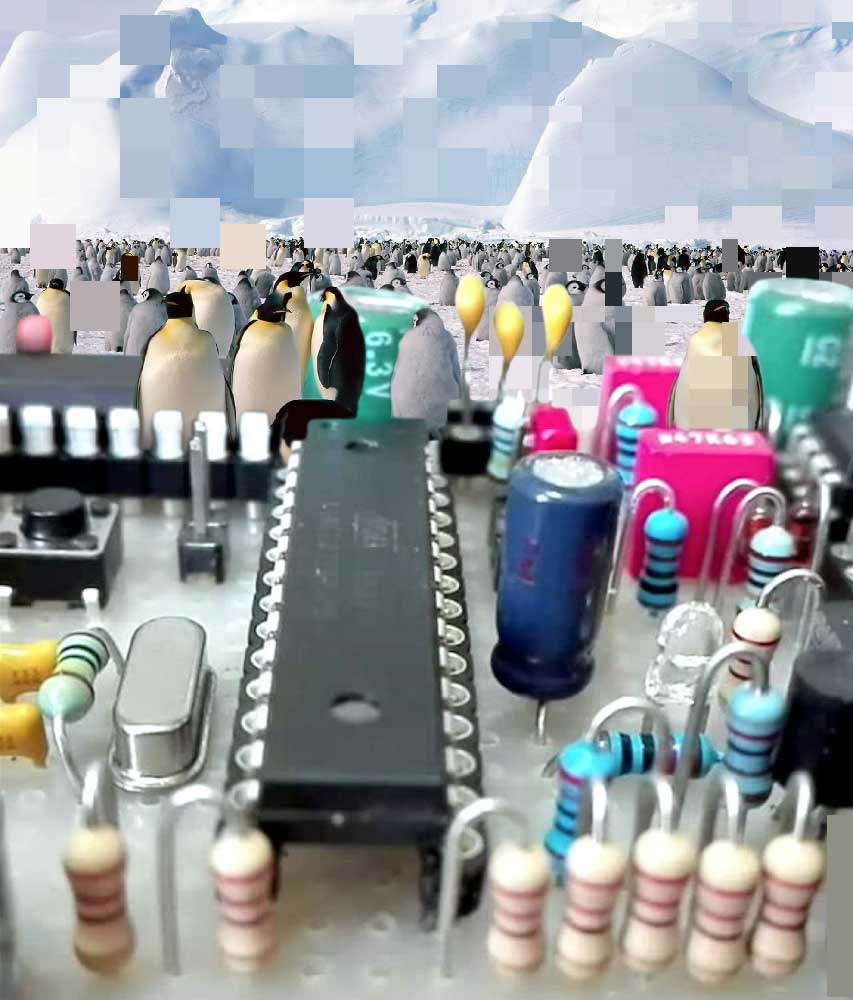Sketching forms of electrical life for a new series of works in progress. Image on the left is an astable multivibrator (oscillator) circuit on the backdrop of wallpaper inspired by Brighton Palace. On the right is a motion detector circuit camouflaged as lichen on an Asian rock.
new
Climate Change in Antarctica /
Kelly Heaton, "Climate Change (Penguins)," 2017. Digital photocollage comprised of an electronic circuit, a photo of Emperor Penguins in Antarctica, and pixel manipulation
Emperor penguins may disappear by the end of this century
By Lakshmi SupriyaJul. 7, 2017 , 10:30 AM
Emperor penguins are known for braving the harsh Antarctic winters, but they might not be able to brave the harsh realities of climate change. That’s the finding of a new study, which suggests that by the end of this century, the world’s largest penguins may be no more. Previous research suggested that rapidly warming air and sea temperatures—which melt sea ice—might cause their numbers to plummet by as much as 19% by 2100. But a new model looks at other factors, including how individual penguins deal with climate change by migrating to places with optimal sea ice coverage. In their model of potential penguin migrations, researchers looked at how far penguins typically go and what factors figure in their decisions. They used data previously collected from Pointe Géologie in Antarctica along with satellite images of penguin colonies that revealed information about their traveling and foraging behavior. The model projects that for the next 2 decades, populations will remain stable, and may even increase slightly as the penguins move to locations that are more habitable. After 2050, it all goes downhill. Although the rate of population decline may vary, by the year 2100 almost all emperor penguins may be gone, the researchers write in an upcoming issue of Biological Conservation. That’s because climate change will have rendered all their habitats inhospitable by then. Gaining endangered status under the U.S. Endangered Species Act, the scientists say, may be one way of arresting what might otherwise be their final march.
Posted in:
DOI: 10.1126/science.aan7070
http://www.sciencemag.org/news/2017/07/emperor-penguins-may-disappear-end-century
open studio: electronic sculpture garden /
One my early studies for a sculpture garden that blends nature, electronics and people. Kelly Heaton, November 2015
As usual, I am working on several projects in parallel. My mind refuses to stay contained within a discipline or focused on a single task for more than a few days (or a few hours)... so I no longer try. Anyway, it seems that everyone is becoming "attention multiplexed."
As we enter into the Anthropocene, the era in which human activity shapes the geologic history of Earth, the distinction between nature and technology is increasingly blurry. Nature has an ecology, electronics have an architecture, and both are systems for the distribution of energy. The merging of living systems fascinates me.
One of my new projects is to design a grand garden that is modeled after a circuit board, to weave landscape architecture and electrical engineering into a functional, natural circuit. The sculptures in the garden will be human-scale electronic devices, enabling visitors to "meet" technology face-to-face, and to walk the pathways within the circuit. Some elements of the garden will be formal, recalling classic electrical engineering on the tidy green "lawn" of a printed circuit board. Wilder areas of the garden will play with nature and technology as (a)live, interconnected, and dissolving into one and other over time. I love the idea of trees building a subterranean circuit with their roots; soil churning with chemical, fungal and animal messengers; vines growing over electronics like unruly wires; cisterns that collect water from the sky, feeding channels and powering kinetic mobiles; and shrines that worship Gods of Power, be it natural or manmade.



